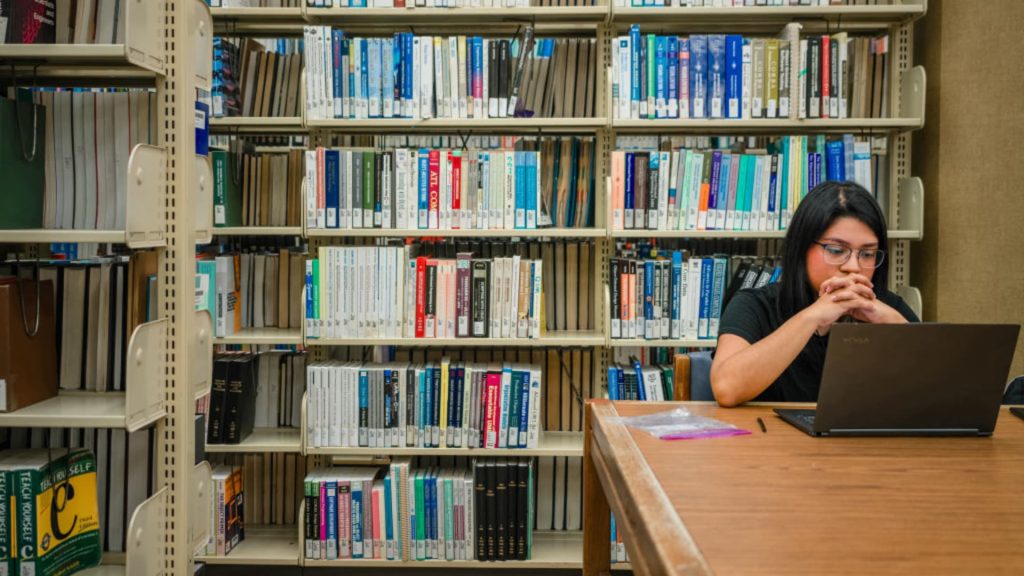U.S. Secretary of Education Linda McMahon smiles during the signing event for an executive order to shut down the Department of Education next to U.S. President Donald Trump, in the East Room at the White House in Washington, D.C., U.S., March 20, 2025.
Carlos Barria | Reuters
In a Wall Street Journal op-ed, U.S. Secretary of Education Linda McMahon explained the U.S. Department of Education’s decision to restart collections on federal student loans that are in default — and what comes next for Federal student loan borrowers who are behind on their bills.
“On May 5, we will begin the process of moving roughly 1.8 million borrowers into repayment plans and restart collections of loans in default,” McMahon wrote in the op-ed Monday.
“Borrowers who don’t make payments on time will see their credit scores go down, and in some cases their wages automatically garnished,” McMahon wrote.
Next steps for borrowers
Federal student loan borrowers in default will receive an e-mail over the next two weeks making them aware of this new policy, the Education Department said.
These borrowers should contact the government’s Default Resolution Group to make a monthly payment, enroll in an income-driven repayment plan, or sign up for loan rehabilitation.
The Education Department said it is extending the Federal Student Aid call-center operations with weekend hours as well updating a “loan simulator” to help borrowers calculate their repayment plans. There is also an artificial intelligence assistant, dubbed Aidan, to help with a financial strategy.
“We are committed to ensuring that borrowers are paying back their loans, that they are fully supported in doing so, and that colleges can’t create such a massive liability for students and their families, jeopardizing their ability to achieve the American dream,” McMahon wrote.
‘Be proactive’
Those borrowers who are behind in their required payments should avoid being placed in default by taking advantage of various options currently available to them to manage their education loans, advised Kalman Chany, a financial aid consultant and author of The Princeton Review’s “Paying for College.”
“Be proactive,” he said. “Best to take care of this as soon as possible, as the loan servicers’ and the U.S. Department of Education’s customer support will get busier the closer it gets to May 5.”
The Education Department has not collected on defaulted student loans since March 2020. After the Covid pandemic-era pause on federal student loan payments expired in September 2023, the Biden administration offered borrowers another year in which they would be shielded from the impacts of missed payments. That relief period officially ended on Sept. 30, 2024.
“President Biden never had the authority to forgive student loans across the board, as the Supreme Court held in 2023,” McMahon wrote. “But for political gain, he dangled the carrot of loan forgiveness in front of young voters, among other things by keeping in place a temporary Covid-era deferment program.”
McMahon said restarting collections of loans in default was not meant “to be unkind to student borrowers.” Rather, the new policy intended to protect taxpayers. “Debt doesn’t go away; it gets transferred to others,” she said. “If borrowers don’t pay their debts to the government, taxpayers do.”
Currently, around 42 million Americans hold federal student loans and roughly 5.3 million borrowers are in default.
“It really is time to start repaying again,” Maya MacGuineas, president of the Committee for a Responsible Federal Budget said in a statement. “While a short repayment pause was justifiable early in the pandemic, that was five years ago — and it makes no sense today.”
More from Personal Finance:
Is college still worth it? It is for most, but not all
How to maximize your college financial aid offer
Top colleges roll out more generous financial aid packages
President Donald Trump in March signed an executive order aimed at dismantling of the Education Department after nominating McMahon for Education secretary. Trump suggested that she would help gut the agency. As part of this overhaul, federal student loan management was then shifted to the Small Business Administration.
Along with changes to the student loan system, the Trump administration revised some of the Department of Education’s income-driven repayment plans, which put at-risk borrowers in “economic limbo,” according to Mike Pierce, executive director at the Student Borrower Protection Center.
“For five million people in default, federal law gives borrowers a way out of default and the right to make loan payments they can afford,” Pierce said in a statement. “Since February, Donald Trump and Linda McMahon have blocked these borrowers’ path out of default and are now feeding them into the maw of the government debt collection machine.”

